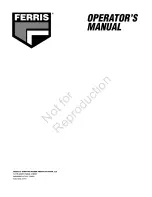
Not for
Reproduction
WARNING
For your personal safety, use extreme care when jump starting.
Never expose battery to open flame or electric spark – battery
action generates hydrogen gas which is flammable and
explosive. Do not allow battery acid to contact skin, eyes,
fabrics, or painted surfaces. Batteries contain a sulfuric acid
solution which can cause serious personal injury or property
damage.
To avoid engine damage, do not disconnect battery while
engine is running. Be sure terminal connections are tight before
starting.
61
This hook-up is for negative grounded vehicles.
Description
Callout
To Starter Switch
A
Starting Vehicle Battery
B
To Ground
C
Jumper Cable
D
Discharged Vehicle Battery
E
Engine Block
F
Make sure vehicles do not touch.
1.
Both batteries must be of the same voltage.
2.
Position the vehicle with the booster battery adjacent to the
vehicle with the discharged battery so that booster cables
can be connected easily to the batteries in both vehicles.
Make certain vehicles do not touch each other.
3.
Wear safety glasses and shield eyes and face from batteries
at all times. Be sure vent caps are tight. Place damp cloth
over vent caps on both batteries.
4.
Connect positive (+) cable to positive post of discharged
battery (wired to starter or solenoid).
5.
Connect the other end of same cable to same post marked
positive (+) on booster battery.
6.
Connect the second cable negative (-) to other post of
booster battery.
7.
Make final connection on engine block of stalled vehicle
away from battery. Do not lean over batteries.
8.
Start the engine of the vehicle with the booster battery. Wait
a few minutes, then attempt to start the engine of the vehicle
with the discharged battery.
9.
If the vehicle does not start after cranking for ten (10)
seconds, STOP PROCEDURE. More than ten (10) seconds
seldom starts the engine unless some mechanical
adjustment is made. Allow a sixty (60) second cool down
period between starting attempts. Failure to follow these
guidelines can burn out starter motor.
10. After starting, allow the engine to return to idle speed.
Remove the cable connection at the engine or frame. Then
remove the other end of the same cable from the booster
battery.
11. Remove the other cable by disconnecting at the discharged
battery first and then disconnect the opposite end from the
booster battery.
12. Discard the damp cloths that were placed over the battery
vent caps.
WARNING
Any procedure other than the preceding could result in:
(a) personal injury caused by electrolyte squirting out the
battery vents,
(b) personal injury or property damage due to battery explosion,
(c) damage to the charging system of the booster vehicle or
of the immobilized vehicle.
Do not attempt to jump start a vehicle having a frozen battery
because the battery may rupture or explode. If a frozen battery
is suspected, examine all fill vents on the battery. If ice can be
seen or if the electrolyte fluid cannot be seen, do not attempt
to start with jumper cables as long as the battery remains
frozen.
Troubleshooting
Troubleshooting Charts
Troubleshooting the Rider
Remedy
Cause
Problem
37








































